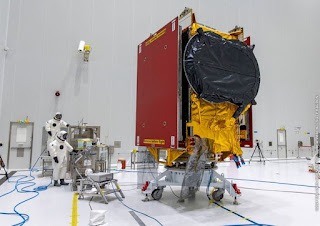The NISAR satellite, constructed on opposite sides of the Earth, will advance knowledge of climate change, deforestation, glacier melt, volcanoes, earthquakes, and other phenomena.
In Bengaluru, India, NISAR's components converged, birthing a singular spacecraft and entwining their purpose in cosmic unity. NISAR, short for NASA-ISRO Synthetic Aperture Radar, is being built jointly by NASA and the Indian Space Research Organisation, or ISRO, to observe the movements of Earth's land and ice surfaces in incredibly fine detail. With an upcoming launch set for early 2024, anticipation fills the air. NISAR will aid scientists in understanding, among other observables, the dynamics of forests, wetlands, and agricultural fields as it scans practically every area of our world at least once every 12 days.
The cylindrical payload of the satellite's radar equipment is about the size of an SUV and is partially covered in gold thermal blanketing. While the L-band instrument can penetrate thick forest canopies to investigate the wooden trunks of trees, among other observables, the S-band instrument is particularly effective for monitoring crop structure and the roughness of land and ice surfaces. Both S-band and L-band sensors can gather data day and night, and their respective wavelengths are around 4 inches (10 centimetres) and 10 inches (25 centimetres). Both signals can see through clouds.
In order to arrive at this location, the payload travelled in circles. Engineers created the S-band radar at the Space Applications Centre in Ahmedabad, western India, and then it was flown to NASA's Jet Propulsion Laboratory in Southern California in March 2021, where they were working on the L-band radar that NISAR had been constructing. Before being flown to the U. R. Rao Satellite Centre (URSC), located in Bengaluru, southern India, in March 2023, the two systems were attached to the payload's barrel-shaped frame at JPL.
The payload travelled in circles before arriving at this location. The S-band radar was created at the Space Applications Centre in Ahmedabad, western India, and was then flown in March 2021 to NASA's Jet Propulsion Laboratory in Southern California, where scientists had been working on NISAR's L-band radar. The two systems were attached to the payload's barrel-shaped frame at JPL before being flown to the U.R. Rao Satellite Centre (URSC) in Bengaluru, southern India, in March 2023.
Teams from NASA and ISRO have been collaborating to run thousands of feet of cable between the radar payload and bus since their connection in a URSC clean room in mid-June. Solar panels and a wire-mesh reflector in the shape of a drum that will extend from the end of a 30-foot (9-metre) boom are still to be attached to the satellite. The reflector will be the biggest radar antenna of its sort ever launched into space, with a diameter of around 40 feet (12 metres).
The NISAR satellite is presently undergoing performance testing, which will be followed by numerous iterations of environmental testing to make sure it can resist the rigours of launch and fulfil all of its operational needs while in orbit. Following that, it will be carried about 220 miles (350 km) east to Satish Dhawan Space Centre, where it will be put into its launch fairing, mounted atop ISRO's Geosynchronous Satellite Launch Vehicle Mark II rocket, and launched into low Earth orbit.
Details of the Mission
NISAR is the first hardware development collaboration between NASA and ISRO for an Earth-observing mission, and it is an equal partnership between the two organisations. The Caltech's operational expertise at JPL in Pasadena for NASA is driving a significant part of the project, providing the mission's cutting-edge L-band SAR technology. In addition, NASA is providing the GPS receivers, solid-state recorder, deployable boom, payload data subsystem, radar reflector antenna, and high-rate communication subsystem for science data. The spacecraft bus, the S-band SAR electronics, the launch vehicle, and related launch services and satellite mission operations are all provided by URSC, which is leading the ISRO component of the mission.Details of the Mission




0 Comments